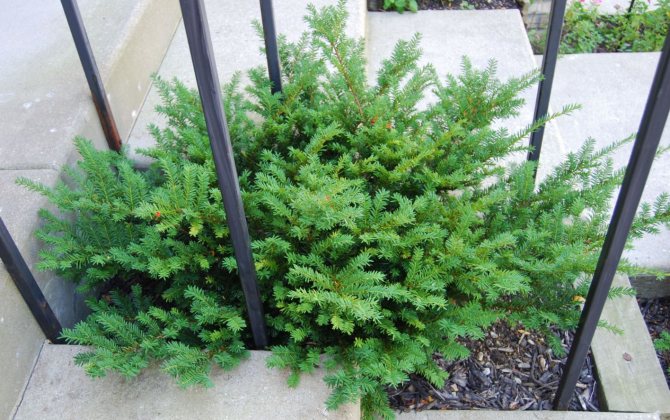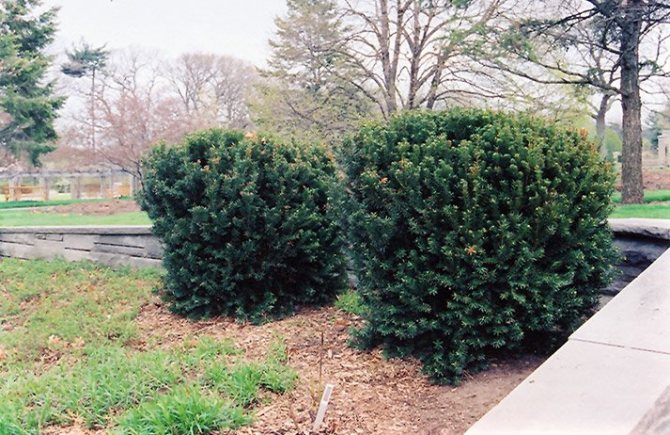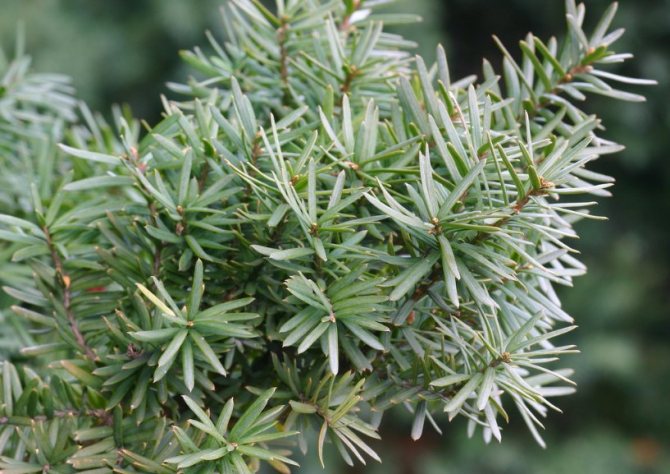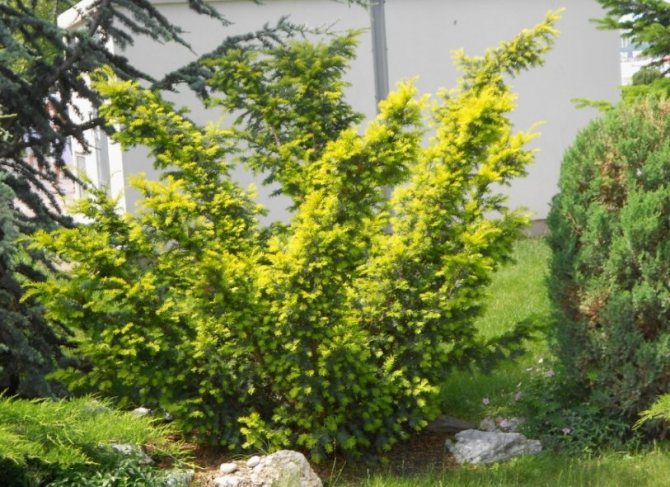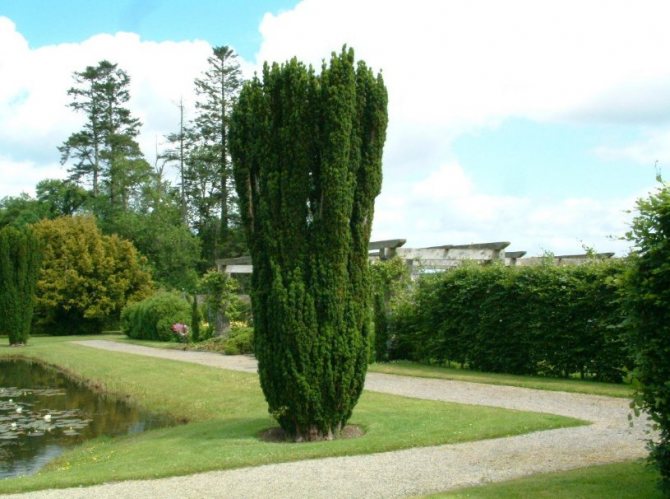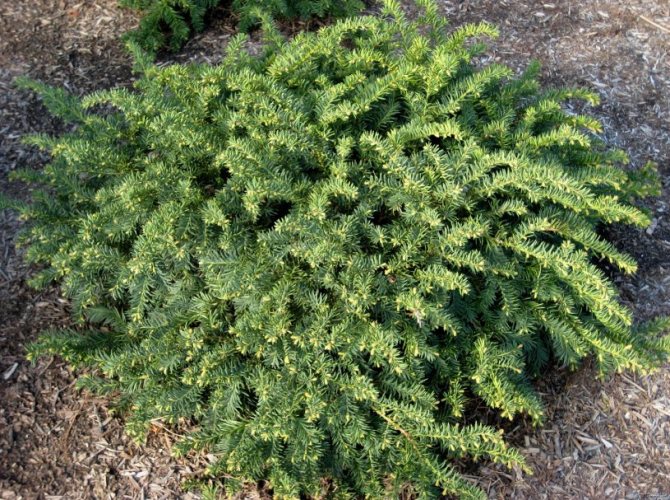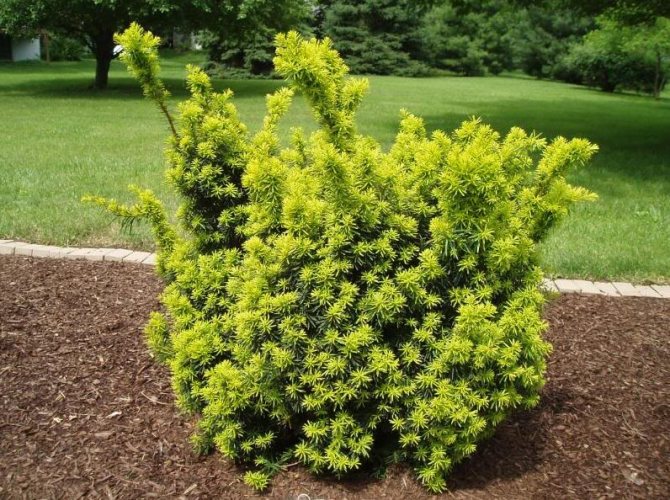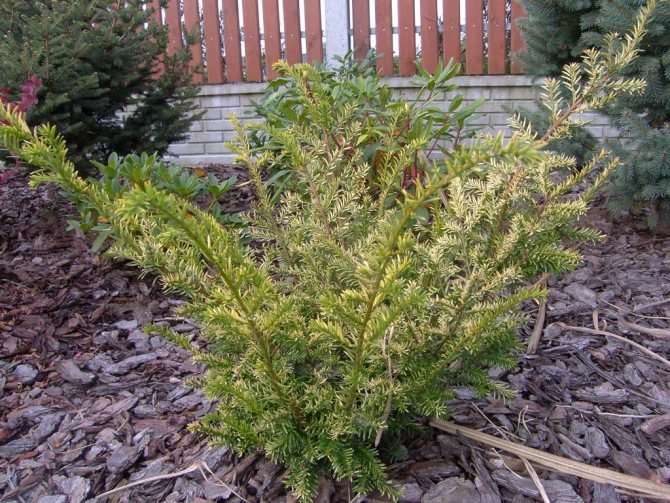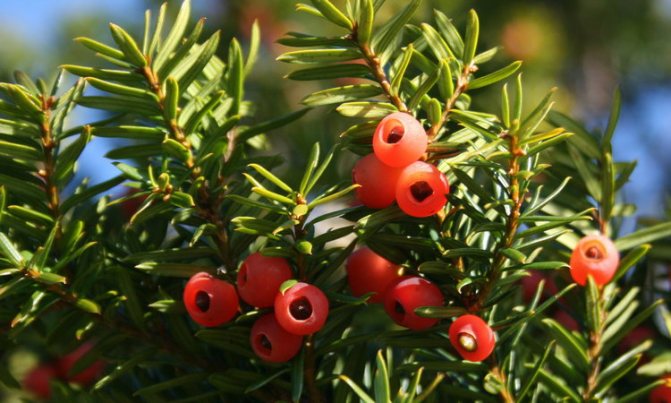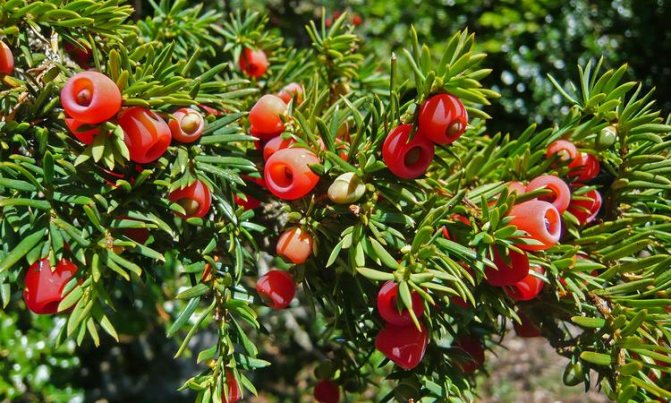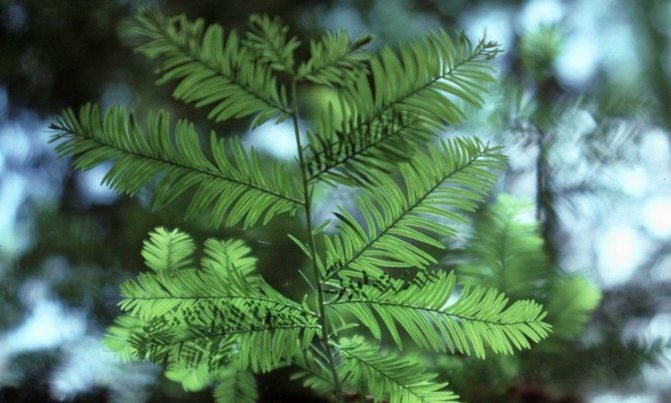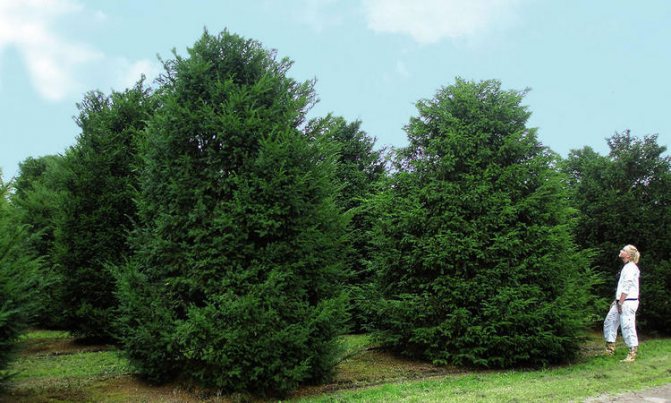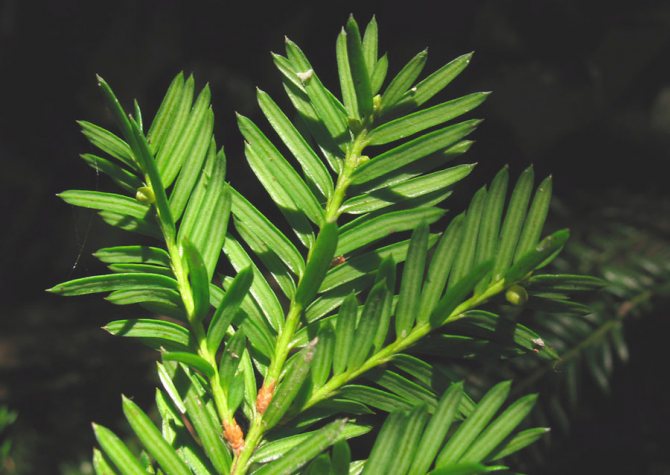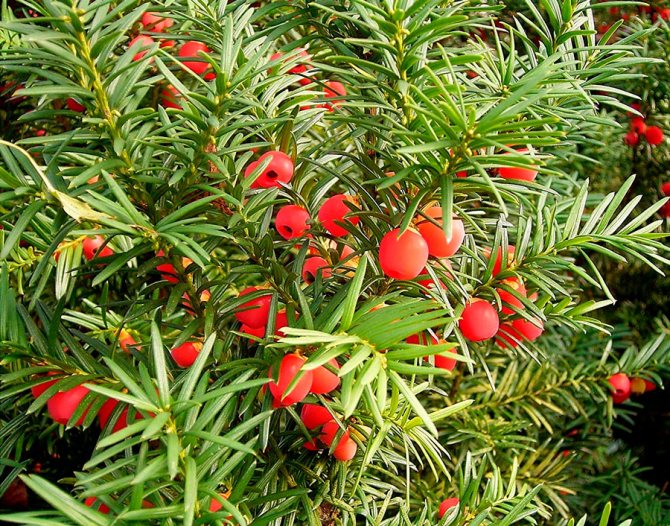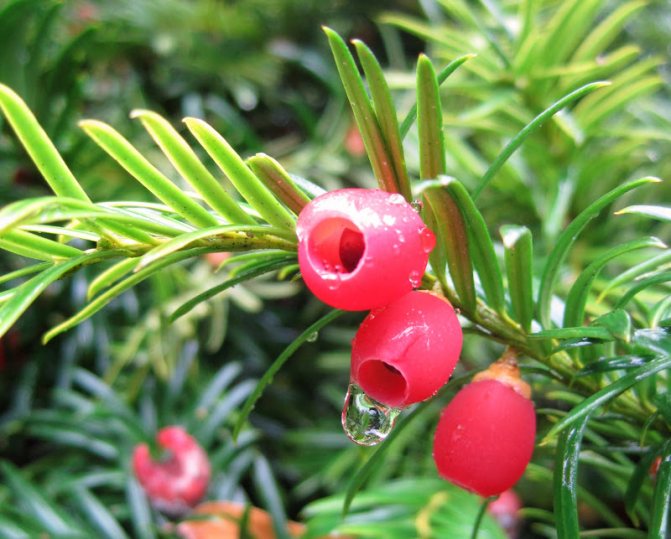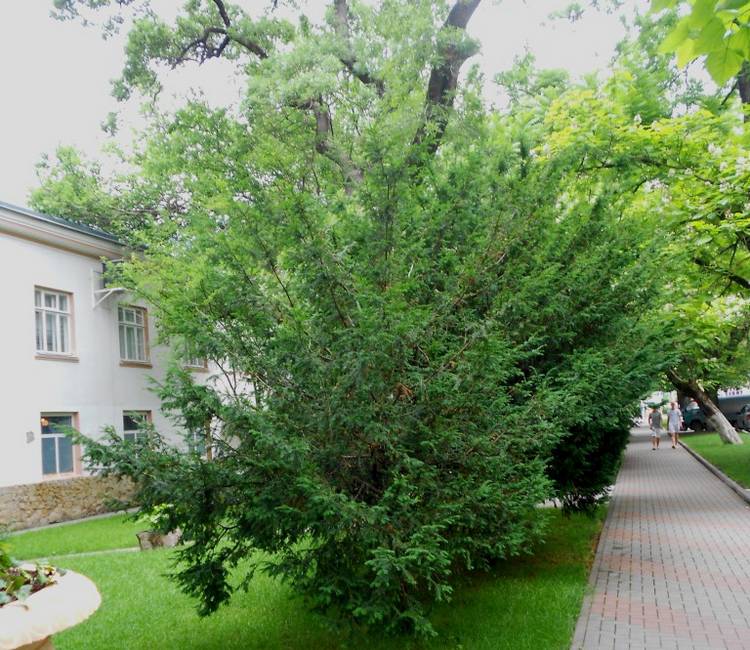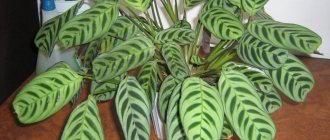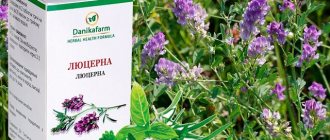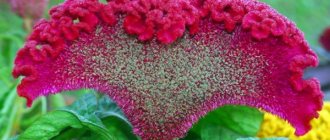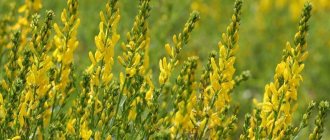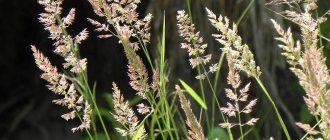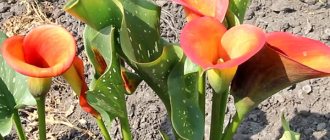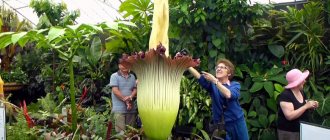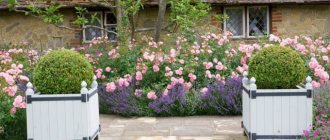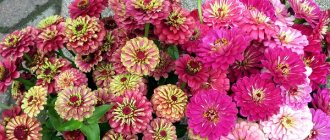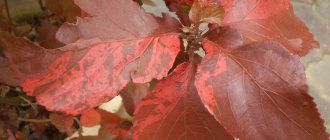A tree-like shrub called "berry yew" has a rich history. Even in the days of Ancient Egypt, this representative of the plant world was highly valued for its beautiful, durable wood with unique bactericidal properties. Enviable unpretentiousness makes berry yew, planting and caring for which is very simple, a favorite plant of many landscape designers. It perfectly tolerates pruning and allows you to create very interesting garden compositions both in single plantings and in curbs and hedges. The peculiar beauty of Taxus baccata lies in the surprisingly harmonious combination of juicy green needles and spectacular red berries.
In its natural habitat, this shrub, and sometimes a whole tree, grows mainly in Europe and the Caucasus. There it can reach 30 m in height, but it is quite possible to grow a small neat specimen in the garden.
Botanical description
Berry yew is a coniferous tree characterized by slow growth and long life expectancy. You can grow a two-meter plant in about 20 years. Moreover, it will live for several thousand years.
Yew characteristics:
- The maximum barrel height is 27 m, the diameter is 1.5 m.
- The twigs are covered with dormant buds, thanks to which lateral shoots germinate.
- The bush is dense, lush, has a cylindrical shape, has several tops.
- The bark is smooth to the touch, lamellar, has a red-gray color.
- There is a powerful root system, so the tree is able to grow on different types of soil.
- The length of the needles is 20-35 mm, the needles have a rich dark green color at the top and a less bright shade at the bottom.
- The tree blooms in late April, and the fruits ripen in October.
- Yew cones are solitary, with a single straight ovule.
It is worth noting that the plant is poisonous. Almost all of its parts are dangerous to human health.
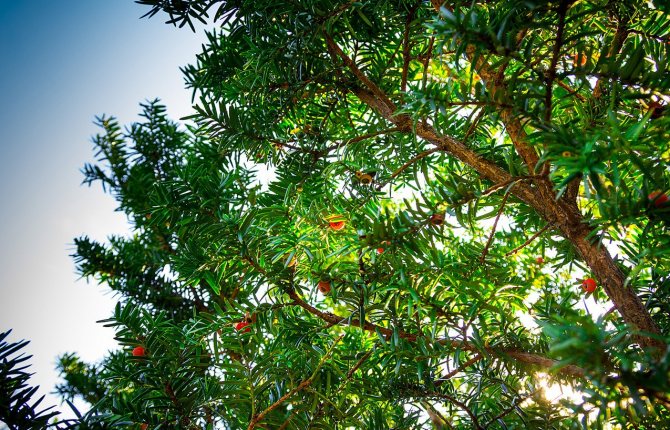
Berry yew lives for several thousand years
Yew species: short-leaved, canadian and pointed (with photo)
Taxus brevifolia — Short-leaved yew
It grows in the west of North America. In the south, it grows in the mountains at an altitude of 1500-2500 m, in the north - along the banks of rivers, in the lakeside lowlands and on low mountain slopes.
Slow growing, often multi-stemmed tree 5-15 m high with a dense, wide-size crown. Young twigs are slightly drooping. In the northern part of the range, and under unfavorable conditions, it takes the form of a creeping bush. The seed coat is intensely red.
Тaxus canadensis - Canadian yew.
It grows in the undergrowth of coniferous forests on the mountain slopes in the East of North America. Low-lying or broadly spreading shrub with a loose crown, rarely rising above 1 m, but reaching 3-4 m in width.
As shown in the photo, the needles of this type of yew for the winter acquire a reddish-brown color:
In comparison with other species of the genus it is less decorative, but it is distinguished by exceptional frost resistance. Cultivars of this species are very valuable for the gardens of the northern regions.
Taxus cuspidata - Yew pointed, or Far Eastern.
A close relative of the berry yew, found in the relict coniferous-deciduous forests of the Far East.
A tree or large shrub, reaching a height of 15-20 m, with a dense spreading crown.In places with unfavorable conditions for growth, it takes on a creeping shape. The bark is smooth, reddish brown. The wood is light red, which is why it is called "rosewood" in the furniture industry. The needles have a small pointed thorn at the end, which gave the name to the species.
These photos show the types of yew, described above:
Popular varieties
Yew is of different types. There are over 150 varieties of it.
The following types of wood are considered the most popular:
- It has a height of 3-5 m, has a dense bark. The needles are dark green, the bushes are branched, lush. The length of the needles reaches 2.5 cm. It takes root well, both on sunny and darkened areas of the earth. It tolerates pruning well, therefore it is suitable for creating green sculptures.
- It is a shrub that grows up to a meter high. But in areas with low air temperatures, growth slows down, so it rarely exceeds 50 cm.The trunk diameter is about 1.5 m. People prefer to choose this particular yew variety for gardening, since it is lush and bright, easily tolerates dry weather.
- It has yellow needles, but in summer the needles can become greenish. They grow up to 2 m in height. They tolerate well the climate in which there is a moderate level of humidity, for example, as in the Crimea. Gardeners are attracted by its beauty and unpretentiousness.
- It is a low-growing shrub that rarely grows more than 50 cm. It has a wide crown, practically spreads on the ground. The needles are dark green in color. Gardeners prefer to use this type to decorate ponds, alpine slides.
These varieties are ideal for growing in gardens, so you should pay attention to them.
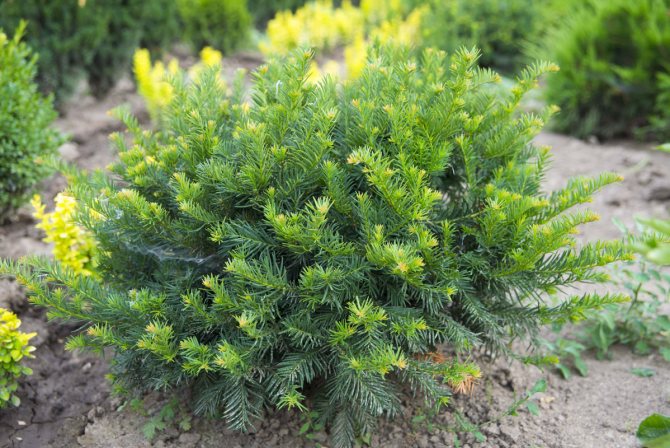

Yew berry bush
Distribution and habitat [edit | edit code]
It grows in Western, Central and Southern Europe (in the north it reaches western Norway, where the world's northernmost natural habitats of the Tees genus are located), in the south of Sweden and the Aland Islands, in northwestern Africa, northern Iran and southwestern Asia.
On the territory of Russia, it is found in the western part of the North Caucasus (Caucasian Reserve, Yew-boxwood grove), Sakhalin and the Kuril Islands. Individual specimens and groups of yew are found in the Kaliningrad region, Belovezhskaya Pushcha (Belarus), in the western regions of Lithuania, Latvia and Estonia [1], in the Carpathians and Crimea (Chatyrdag, Belbek canyon).
Grows in forests (in stands and undergrowth), on plains. In the mountains it rises to an altitude of 2000 m above sea level [1].
Pharmacological properties
Berry yew has beneficial properties, despite the fact that it contains substances that are dangerous to the human body.
The pharmacological action is as follows:
- Suppresses inflammation.
- Reduces pain syndrome.
- Prevents the development of tumor formations.
- Has an anesthetic effect.
Due to these properties, the plant is used in the manufacture of medicines, and is also used in folk medicine.
It is especially popular in the treatment of pathology of the urinary, reproductive system, as well as for headaches, neoplasms of a benign or malignant nature.
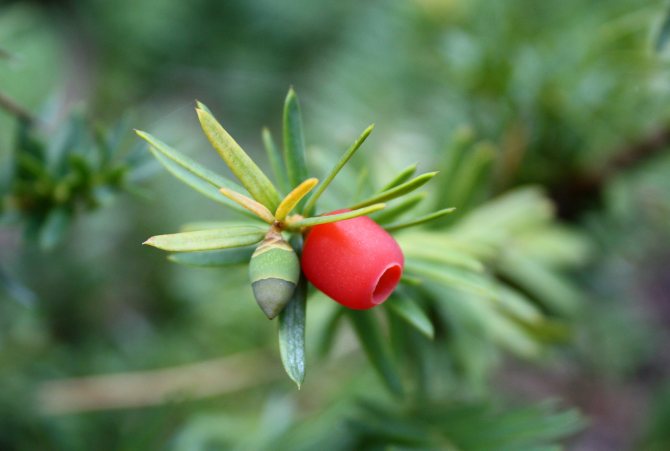

Yew berry is widely used in herbal medicine
Plant appearance
Among the numerous varieties of yew, there are real tree giants, reaching 20-30 meters in height, and there are shrubs, the height of which barely exceeds 2-5 meters. But, regardless of the species, yew grows slowly - the natural increase in height remains almost unchanged throughout life and is 10 cm / year. The tree takes at least 7 years to mature. But any varieties and types of yews live long enough - over 1.5 thousand years. The oldest known tree has already celebrated its 4 thousandth birthday!
With some exceptions, the yew is dioecious.Females and males grow separately.
The branches of yews are flexible and resilient, have a whorled arrangement. The trunks are strong. Members of the genus have a reddish-brown bark and a dense branchy crown. The latter can be multi-tiered or multi-vertex. Yew wood also has a reddish tint, for which it is often called mahogany in everyday life.
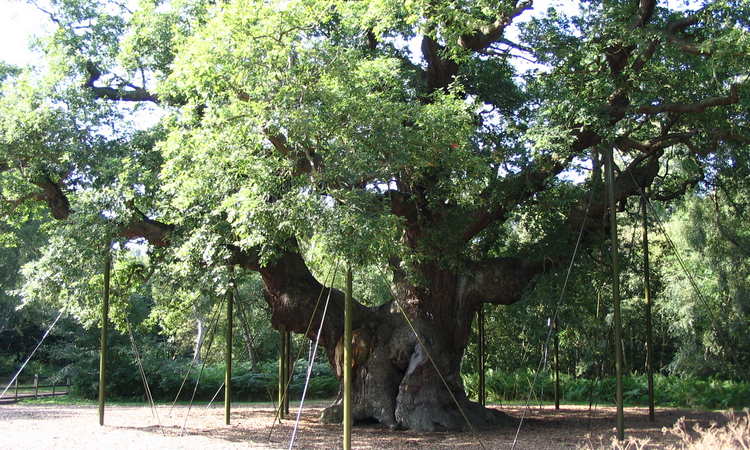

The needles are soft and flat (not needle-like), mostly dark green, but can have a bronze, yellowish or light green tint. On the stems, the needles are placed in a spiral, and on the side branches - in two rows. All parts of the plant contain toxic substances.
Regardless of the type, yew yews are easy to form and easily recover even after heavy pruning. This allows you to shape the plants as you wish.
Chemical composition
Yew contains alkaloids, which are poisonous components.
Specifically, this plant contains the following poisons:
- taxin;
- ephedrine;
- glycoside taxicanthin;
- malosein.
In addition to these substances, there are also the following components:
- vitamins E, K;
- terpenoids;
- steroids;
- taxifylline;
- lignans;
- tannins;
- phenols;
- flavonoids;
- anthocyanins;
- fatty acid;
- higher alcohols;
- carbohydrates.
Due to such a diverse composition, the plant has the above pharmacological properties.
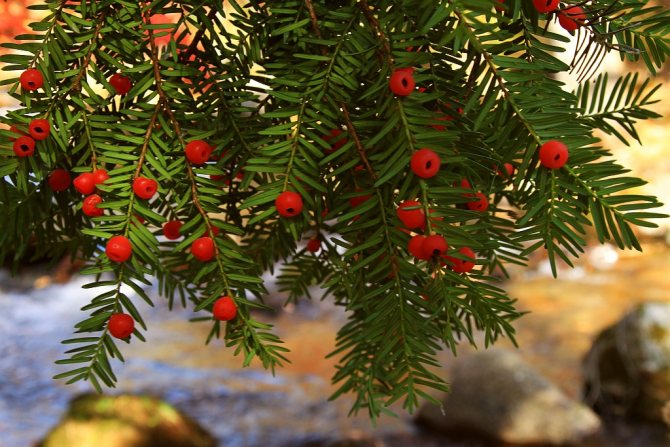

Yew berry contains many useful substances, although the plant is poisonous
Description of the coniferous plant yew
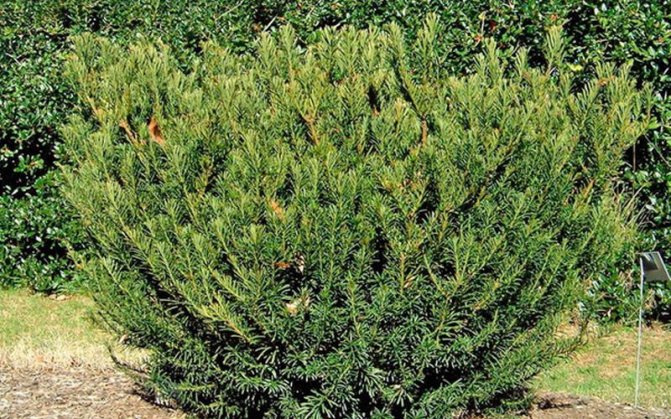

Coniferous plant Yew in the photo
Yew belongs to a very valuable coniferous species. It is the only tree that can withstand full shade. It is easier to cut than other conifers, forming a crown.
In nature, 8 species of yew are known, photos and descriptions of which are presented on this page. They are all small evergreen conifers and shrubs that grow in the temperate to tropical areas of the Northern Hemisphere. Two types of conifers, yew, are found in Russia, one in the Caucasus, the other in the Far East. Both are most in demand as ornamental shrubs and have many dozens of original forms.
The length of the needles is usually 2-3 cm, the width reaches 0.3 cm. Yews are one and dioecious plants belonging to the gymnosperm group, like other conifers. But the fruits of the yew are not at all like the cones of pines and firs. They look like berries, the seed of which is almost completely hidden by the fleshy pericarp.
The following is a description of the yew tree of various types and their varieties.
Reproduction of yew
Reproduction of yew berry occurs in two ways, each has its own characteristics.
Seeds
This method is quite lengthy and complex, so be patient. Seeds can take several years to germinate. There are times when sprouts appear 3 years after planting. This is not surprising, because germination lasts up to 4 years.
Also, the difficulty lies in the fact that not all seeds are suitable for growing yew.
After all, this tree is dioecious. The bush begins to bear fruit already at a respectable age - about 25-30 years.
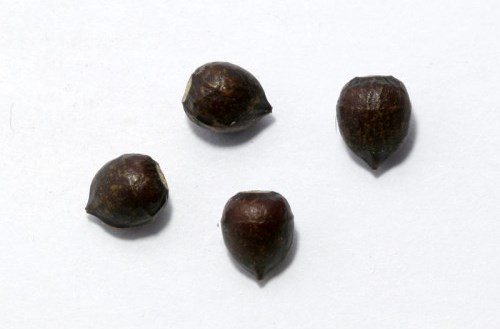

Yew berry seeds
Cuttings
The easiest way to propagate yew is by cuttings. It is especially suitable for ornamental varieties. Rooting is possible for both annual and biennial shoots.
When cutting the cuttings of branches growing up, the bushes are elongated. If cut from horizontal branches, lower, lush shrubs grow.
Cutting should be done in autumn. Cut off about 15-20 cm from the tops. The needles located below must be removed. Cut cuttings are placed in seedling boxes, and in winter they are transferred to a greenhouse.
The soil for successful growth should consist of sand and peat in a 1: 2 ratio. Rooting continues for 3 months.


Planted cuttings of yew berry
Yew wood
Yew wood has long been valued for its high strength, beautiful appearance, and the ability to resist rot and fungus. It is known that this material cleans the surrounding air from pathogenic microbes, making the microclimate healthy.
The core of the yew tree, in contrast to the light yellow sapwood, has a red or purple color, which darkens even more over time, the texture of the massif is almost uniform. When drying often warps and cracks, but is stable in use. The density of wood depends on the type and ranges from 570 to 812 kg / cubic meter. For many centuries, houses were built from this material, furniture was cut out, used for interior decoration of premises, fighting and hunting bows, bodies of musical instruments were cut from it.
Today, yew is not used in general industry, as it is classified as an endangered plant species. Sometimes there are various handicrafts and souvenirs made from it, which have collectible and artistic value, and exclusive furniture.


Diseases and pests
Every plant runs the risk of being negatively affected by diseases or pests. Berry yew is no exception.
Diseases
The following pathologies are characteristic of yew:
- brown shute;
- phomosis;
- necrosis;
- fusarium.
IMPORTANT! (click to find out)
The clinical signs of these diseases are different. But you can already suspect unfavorable changes in appearance. It begins to change its color, dry out, fall off.
The following factors are capable of provoking the development of pathologies:
- mechanical damage to the bark;
- penetration into the needles of fungal microorganisms;
- growing in a place where there is heavy clay soil.
For treatment, it is required to improve drainage, eliminate excess water from the soil.
You should also spray the diseased tree with "Biofungicide". For prophylaxis, it is recommended to carry out the treatment with "Fungicide" in the fall and spring, which contains copper.
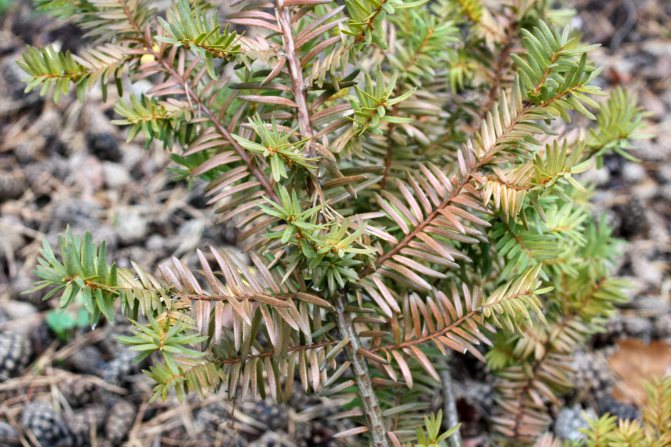

Phomosis of yew berry
Pests
The berry yew tree can be subject to such pests as:
- gall midges;
- yew false shields;
- needle-eaters;
- pine scoops.
The activity of pests is accompanied by a deterioration in the condition. The bush begins to turn yellow, dry out, the twigs die off.
To prevent the attack of harmful creatures, it is necessary to process the needles and the bark itself with the following preparations every spring:
- "Nitrafen".
- "Karbofos".
If pests attack a tree during the growing season, then it is better to use a remedy such as "Rogor".
Usually, harmful insects are completely destroyed after two treatments.
The second should be carried out 10 days after the first. The drug is the same for both procedures.
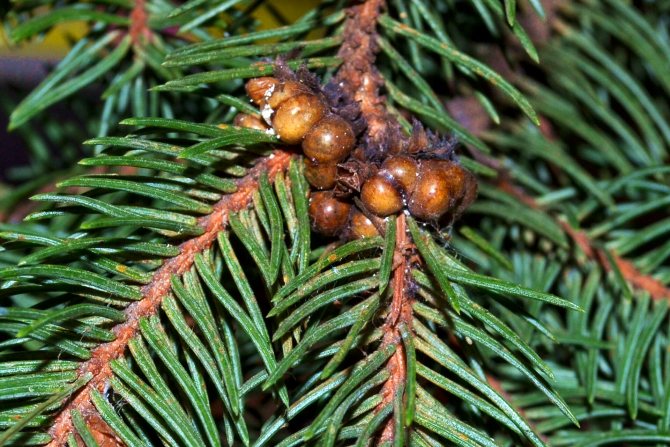

Yew false shields - plant pests
In culture [edit | edit code]
In ancient times, the yew tree was considered the tree of death. Furies were depicted with torches made of yew branches. The Eleusinian priests adorned themselves with wreaths of myrtle and yew branches [14].
The mention of the yew is found in Ovid's Metamorphoses:
There is a path along the slope, shaded by an ominous yew, To hellish dwellings, she silently leads away without people [15].
Do not let the yew grow near the apiary [16].
The yew wreath is mentioned in Seneca's tragedy "Oedipus":
… The priest dressed in funeral robes In the garment of sorrow the elder walks mournfully, The gray yew is crowned, bringing death [17].
In ancient Russian literature, a mention of the yew tree can be found in the Word about Igor's regiment:
See the night and the evening overwhelm me, speech (Svyatoslav
), black daddy, on the beds
yews
…
Probably, here the yew bed does not mean so much furniture as it serves as a symbol of the coffin [18].
A branch of a yew tree that was at Night, the moon just went down,
- one of the ingredients of the potion of witches in the tragedy of W. Shakespeare "Macbeth" [19]. The yew is also mentioned in the songs of the jester in the comedy "Twelfth Night":
Let them put the yew branches in my last shelter. The most devoted friend cannot share my fate with me [20].
It was believed that the shade of a yew tree is poisonous, so you cannot sleep in the shade of a yew tree. Yew was often used as a plant-amulet, since according to legend, evil spirits eschew the yew.
In the medieval Celtic legend of Tristan and Isolde, the yew is a symbol of love. Isolde was ordered to leave Tristan when the leaves fell from the trees, and she resolved the issue as follows:
Three trees grow in our forest: ivy, holly and red yew. They do not lose foliage in winter, - Now Tristan will always be mine [21].
Two yews grew on the graves of their beloved, three times King Mark cut them down, but they appeared again, in the end the king allowed the trees to grow. Over time, their branches closed and intertwined so that it became impossible to separate them [22]. In the II poem of the poetic cycle by Alfred Tennyson "In Memoriam" -
An old yew grabbed the stone ... Under the stone the dead man sleeps without dreams. The crown was wrapped around the head of the roots, The bones were intertwined with the roots.
Yew is an important part of the landscape and in his poem "Enoch Arden":
The road to the mill and the shadow cut through, And the yew-peacock and the lonely castle ...
Philip's house, facing the street, The last one to the shore stood; and behind, With a gate overlooking the wasteland, Pestrel was a walled garden; An evergreen ancient yew grew here ... [23]
In "Flowers of Evil" by Charles Baudelaire, the yew was chosen for reflection by owls:
Where yews lay harsh gloom, Like idols, behind a row, Leading into the dusk a red gaze, Owls sit and reflect [24].
Owls beat against the glass, a raven croaked on an old yew tree, and the wind wandered, groaning like a restless soul, around the old house [25].
In The Great Wheel of Returns by William Yates, Yates appears as part of the material for a kind of tablets -
In which tightly grown together, Embracing, apple and yew, All the sagas of love that I knew [26].
Yew berries are poisonous, they poisoned the hero of Agatha Christie's novel "A Pocket Full of Rye", based on which the movie "The Secret of the Blackbirds" was filmed, to which they were added to canned marmalade. Yew berries also appear in another novel by the writer, "The Twisted House," they poisoned a nanny.
A line from a poem by T.S.Eliot -
The blink of a rose and the blink of a yew are equally instantaneous [27]
- became the epigraph to Agatha Christie's novel "The Rose and the Yew Tree". In the poem by Sylvia Plath "The Moon and the Yew" from the collection "Ariel" -
The gothic yew looks sharply upwards. Glancing over it, a glance reveals the moon.
The moon does not look here, Deserted in the void. And the yew repeats Only about silence and blackness [28].
In the poem by Konstantin Simonov "The English military cemetery in Sevastopol" (1939), the yew is mentioned, despite the absence in the landscape, as a typical tree of England:
There is no holly or yew here.
Alien stones and salt marshes, Cypresses corroded by the sun
Like cleavers stuck in the ground.
In the series of novels by J.K. Rowling about Harry Potter, Voldemort had a magic wand of yew with a core of a phoenix feather.
Planting yew in open ground
The procedure for planting yew in open ground is simple, but it requires adherence to some nuances and preparation.
Creating conditions for the plant
Before planting a yew tree, you should know the peculiarities of its cultivation. These include the following:
- Illumination. This plant is not demanding on light, so it is planted in dark areas. In addition, the absence of the influence of bright sunlight allows the tree to become more resistant to frost, retain the rich color of the needles and bear fruit well.
- Soil condition. Yew prefers soil that is well hydrated and nutritious. The best option is calcareous or clay type soil. In no case should the soil be sour.
- Humidity. The shrub needs a certain amount of moisture, so if there is a reservoir on the site, then it is worth placing the tree near it.If it gets enough water, the needles retain their vibrant hues. But you cannot be zealous with the liquid, otherwise the tree will not be able to fully develop.
These simple but important rules will help you prepare well for the procedure.
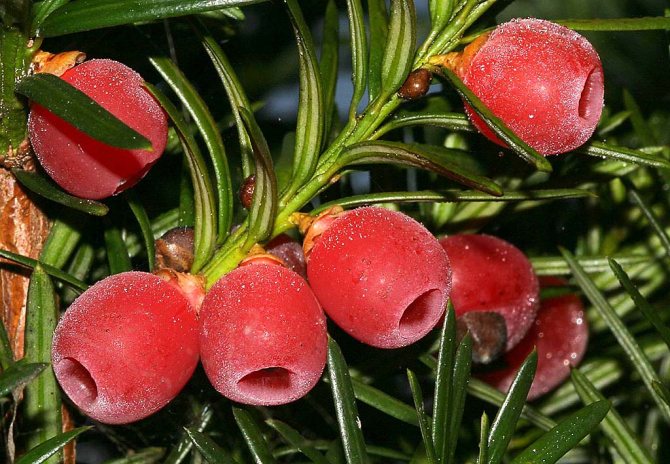

Berry yew loves moist and nutritious soil
Directly planting a seedling
The process begins with the preparation of the pit. Its optimal depth is up to 0.7 m, its width is no more than 0.2 m more than the volume of the root system taken together with the ground. If you plan to create a hedge, you need to dig a trench. Its depth should be approximately 0.5-0.7 m.
The distance between trees for a normal planting is 150-200 cm, when forming a hedge - 50 cm.
At the bottom of the hole, you need to lay out a layer of sand, gravel or pebbles. Thickness - 0.2 m.
IMPORTANT! (click to find out)
Before planting, the seedling must be well watered. Then carefully pull it out of the box and place it in the hole. Fill the hole with prepared soil, mixed with all the necessary fertilizers, for example, with "Nitroammofoska", copper sulfate.
The soil around the tree should be carefully tamped, then watered and covered with a layer of mulch, for example, peat.
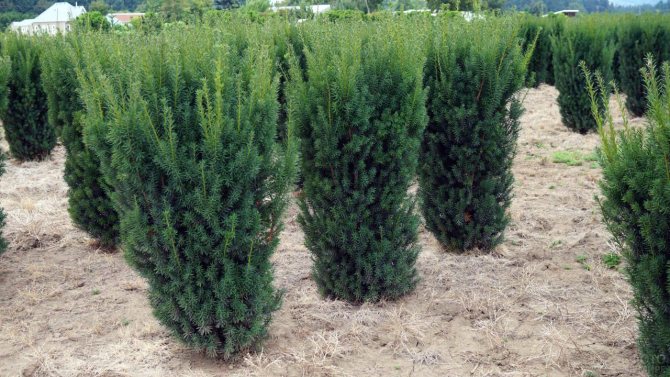

Yew berry seedlings
Wild landscape
Evergreen yews look beautiful throughout the year, and most of the plants in this species have fluffy, dense needles. Many pleasant pastel or bright shades will add variety and elegance to the coniferous composition. In principle, it is not at all necessary to shape the crown if you want to create a garden in a natural style.
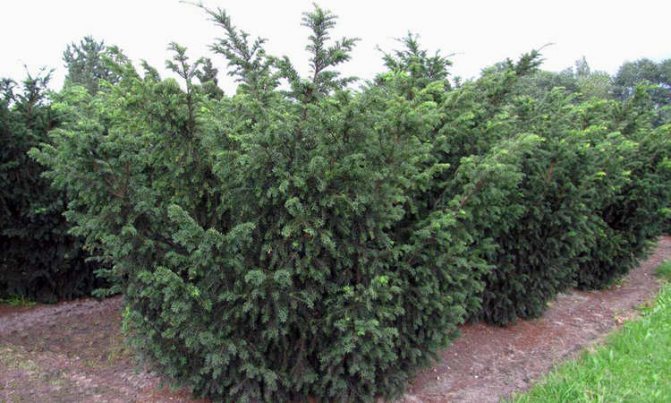

For example, recreating a wild piece of forest, as if it were a site in the Alps, Carpathians, and not artificially planted plants. Trees are planted in the background, leaving space for wild bushes and rocks between them. Asymmetry and restraint play a key role here.
Yew Garden Care
Caring for the yew berry assumes timely watering, loosening, pruning and providing nutrients for better growth.
Top dressing
All necessary approvals can be entered immediately upon planting. In this case, the plant will no longer need feeding. This volume will be enough for him for the whole year. But subsequently, you will need to feed the yew annually.
RECOMMENDATION! (click to find out)
It is recommended to use "Kemiru-universal" for this purpose. The dosage is 100 g per 1 square meter. You can also use "Nitroammofoska" in the amount of 50-70 g per 1 square meter.
Watering
Yews less than 3 years old need to be watered regularly. Watering frequency is once a month. For one bush, you need to spend 10-15 liters of water.
An adult tree does not need frequent watering. Usually rain is enough for him to maintain life. Also, yew is able to take liquid from the soil, since it has a powerful root.
But with prolonged dry weather, there will be little rainwater for the tree. In such conditions, regular watering is required.
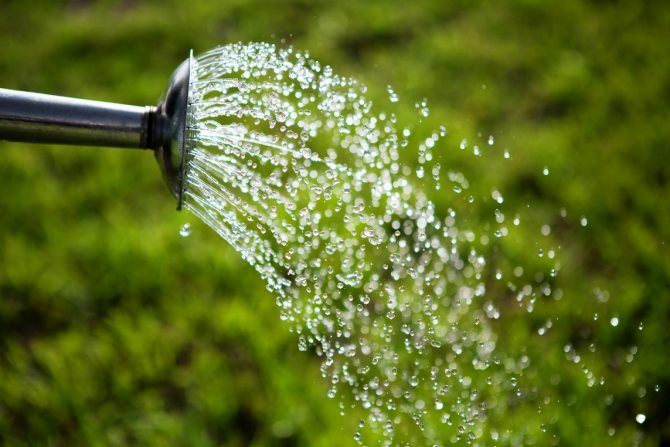

Yew needs to be watered regularly
Loosening
It is necessary to loosen the soil to a depth of 10-15 cm. This is especially important in the first 3 years of cultivation in the open field. If this rule is neglected, a crust will form on top of the earth. Because of it, the access of oxygen to the roots of the plant will be difficult. This will negatively affect the growth and development of the bush.
All weeds should be removed along with loosening. After all, it is from them that pests often come.
The need for too frequent loosening will disappear if you fill the soil under the trunk with a ten-centimeter layer of mulch, for example, sawdust or peat. This will also help to avoid the attack of harmful insects and keep the soil moist for a long time.
Pruning
Yew grows rather slowly. Therefore, in the early years of cultivation, circumcision will not be necessary. Then you will need to trim it periodically.
It should be noted that this procedure does not harm the yew tree, even if the pruning is strong.
RECOMMENDATION! (click to find out)
It is recommended to cut the stems 1/3 of the length, no more.It is imperative to remove all dried branches, as well as those that are affected by frost or diseases.
Circumcision is best done in early April, before the kidneys are swollen.
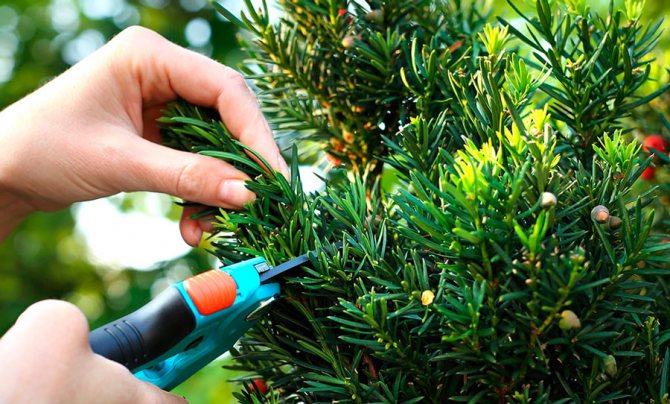

Yew pruning
Fertilization and feeding of berry yew
In the process of growing, the plant needs several fertilizers:
- When landing. Before placing the seedling in the hole, apply a universal mineral mixture - 100 g / m2.
- Re-feeding with the same complex - 70 g / sq.m.
- Annual fertilization in spring with rotted organic matter - once a season.
- Annual summer feeding with liquid mullein - 2 times a season.
Advice. Dig up the topsoil before fertilizing.
Yew application
Berry yew is used in various fields.
Use in landscape design
Yew is often used to create a beautiful landscape, especially for the formation of graceful hedges.
The plant is unpretentious, therefore it is grown without any problems and decorates plots at houses.
The main thing is to trim the bushes in a timely manner. You can even make different shapes from them.
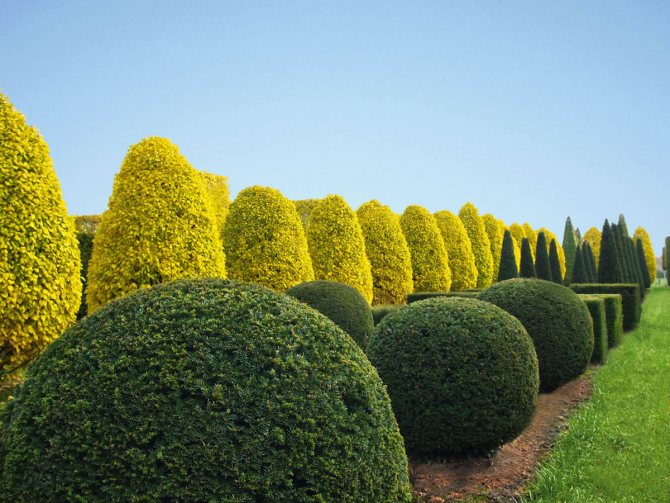

Topiary yew haircut
In cooking
You cannot eat any part of the bush. Even berries that do not contain toxic substances are not allowed to eat. The reason is that the seeds of the fruit themselves contain strong toxins that are dangerous to health.
Application in traditional medicine
Folk remedies based on yew help in the treatment of various diseases of internal organs, and also allows you to get rid of dermatological diseases. Preparations using this plant treat inflammatory, tumor processes, eliminate pain.
Yew is especially popular in the fight against cancerous growths. On its basis, a medicinal tincture is prepared.
It is prepared as follows:
- Pour 150 g of dry branches with bark with 1.5 liters of vodka;
- seal tightly with a lid;
- let it brew for 2 months in a place protected from sunlight.
The resulting folk medicine is highly toxic. Therefore, it must be taken according to a strict scheme.
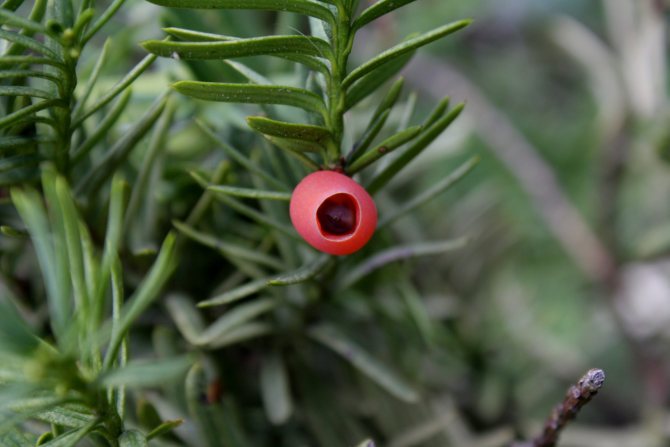

Self-medication with yew is dangerous
The procedure for the treatment is as follows:
- For the first 7 days, take 3 drops in the morning and evening.
- Increase the dosage by 2 drops every week and use it 3 times a day.
- Bring up to 25 drops per day.
- Heal within 2 months.
- Alternate reception - a month for 10 drops, another for 25 drops.
The product can not be drunk in its pure form, you need to dilute them with water in the amount of 30 ml. Take before meals.
Before using, be sure to consult a doctor.
Side effects of using yew
You should not use yew to treat diseases without first consulting a doctor. If you do not calculate even a little with the dosage, you can face dangerous consequences.
The side effects are as follows:
- rapid heartbeat;
- increased blood pressure;
- nausea, vomiting;
- weakness;
- drowsiness;
- difficulty breathing.
These manifestations are associated with poisoning of the body. Therefore, urgent gastric lavage and medical intervention are required. If this is not done in a timely manner, it can be fatal.


Without consulting a doctor, self-administration of herbal remedies based on yew is prohibited.
In gardening
Many people grow trees only as decoration in the garden. After all, they are evergreen, bright, and during the period of fruit formation they are covered with rich red berries.
TIP! (click to find out)
For horticulture, it is recommended to choose low varieties if the climate presupposes long winters.
The bushes will be completely covered with snow, which will protect them from severe frost. After all, too low a temperature can harm the stems and needles.
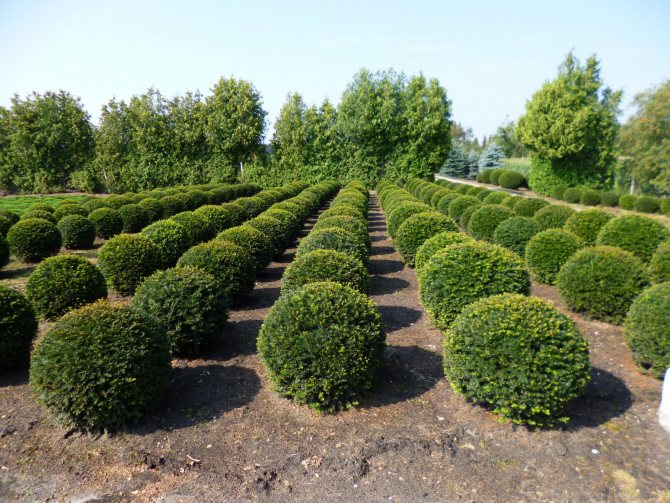

Yew berry - decoration of any garden
In construction
Yew has a fairly heavy, hard and resilient wood that lends itself well to polishing and is resistant to decay. Therefore, it is widely used in the construction of objects located under water, as well as shipbuilding.
Wood is also widely used in turning and joinery production, in the manufacture of furniture, wooden handles.
Due to its active use in construction and production, the plant was subject to frequent felling. Therefore, now it needs protection.
Thus, the berry yew, a photo of which can surprise every gardener, is a luxurious evergreen plant that attracts attention with its appearance. Its parts are poisonous, but at the same time have medicinal properties. Therefore, they are used in medicine.
Economic value and application [edit | edit code]
The bark is suitable for preparing glue for catching birds [1].
Leaves can serve as bioindicators of heavy metals in urban air [1].
Chemical composition. Poisonousness [edit | edit code]
All parts of the plant, except for the seed roof, are poisonous [1].
Thaksin causes severe irritation of the mucous membranes of the digestive tract, accompanied by vomiting and diarrhea; significantly affects cardiac activity, stops breathing. There have been cases of poisoning of various groups of domestic animals (horses, cattle, pigs, sheep, chickens), as well as wild goats. However, cones berries are harmlessly eaten by birds, martens, etc., and yew undergrowth is eaten by wild ungulates. Poisoning of livestock is possible when eating cut branches after shearing yew. A single lethal dose of green branches is (in g): 150-400 for horses, 500 for cattle, 150-200 for sheep, 500 for goats, and 75-100 for pigs. Milk when eaten by lactating animals of yew becomes poisoned, causing diseases of suckling young.
Human poisoning is possible when poisonous seeds get inside. Symptoms of human poisoning: nausea, vomiting, diarrhea, general weakness, abdominal pain, drowsiness, convulsions, suffocation, heart failure, resulting in a state of collapse and death. A lethal outcome can occur within the first hour or within several hours (or the first days) [6]. Pliny the Elder in "Natural History" testifies to cases of poisoning of a person who drank wine from a yew goblet. The older the needles of a yew tree, the more poisonous they are [7].
Wood [edit | edit code]
The wood is strong, hard, resilient, heavy, does not decay, is valued for its beauty and color (yellow-red or brownish-red, changing to purple-crimson in water), over time it darkens and becomes like an ebony. It is used in construction, in joinery and turning, for finishing furniture and musical instruments, in the form of plywood [1].
Berry yew, which originally occupied a very large territory, was almost completely exterminated by man because of its durable and practically "eternal" wood, which has strong bactericidal properties - it kills even those microorganisms that are in the air. A house in which at least the ceiling beams are made of yew is reliably protected from a disease-causing infection, which was extremely valuable during mass epidemics.
Due to the combination of "vitality" and toughness of wood, yew turned out to be one of the best materials for making bows. For example, medieval English longbows were made of yew, which are considered the main weapon with which the British won victories in the Hundred Years War.
Wood is used for ascites, topically (in the form of sawdust) - for bites of rabid dogs [1].
Application in park construction [edit | edit code]
The yew is a valuable park tree. So, this tree was often used to create labyrinths in French parks, large yew bosquets and trellises are available in Versailles. One of the three existing yew forests in Europe is located in the Killarney National Park in Ireland [8].
Yew is usually propagated by cuttings. Cuttings taken from branches directed upward give shrubs with compact vertical growth, and cuttings from horizontal branches, taking root, form sprawling low plants.
Application in medicine [edit | edit code]
In Avicenna's treatise "The Canon of Medicine" (1021), berry yew is presented as a phytotherapeutic agent used for heart diseases [9].
Berry yew is used in classical homeopathy [10].
Since the 1990s, yew tree alkaloids (taxanes) have been used for the manufacture of anticancer agents (paclitaxel, docetaxel) [11] [12] [13].
Taxol in the experiment has cytotoxic, antileukemic and antimitotoxic properties, is used for research purposes. Taxin is used in the UK in chemotherapy for ovarian, breast, rectal, and skin cancers [1].
A decoction of seeds acts on the heart in a similar way to that of foxglove [1].
Fleshy seedlings in Indian medicine are used as a tonic, gastric, expectorant, for flatulence, fresh juice as a diuretic, laxative, syrup - for lung diseases, ascites, hemorrhoids, jelly - for chronic cough, whooping cough, kidney stones [1].
Growing
Plant in any type of soil (except waterlogged). Varieties with green leaves can be planted in direct sunlight or in strong shade. Varieties with golden foliage (with the exception of "Standishii" and "Sumniergold") require protection from the bright midday sun, although in too much shade they can turn green.
Deep planting of yews is contraindicated: plant them so that the root collar is at or slightly above ground level (even after mulching it).
Formation
Yew tolerates pruning easily. The stump left over from a cut tree grows over time with overgrowth. Yew hedges and screens become dense if they are regularly formed.
Balls, cubes, pyramids and intricate shapes are cut from the dense coniferous crown. These figures last for a long time, because yew grows very slowly. You need to skillfully form the crown, because any error will be noticeable for a long time.
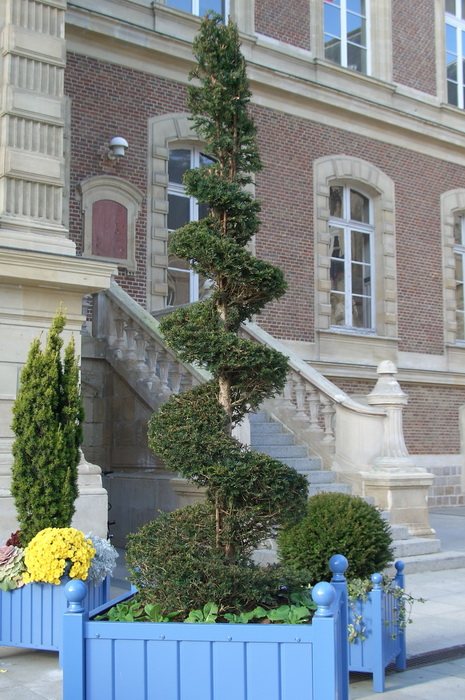

Only craftsmen can form a yew like this.
I like to shape the crowns of a variety of trees and shrubs, decorate the site with garden bonsai. But our yew, which is about fifteen years old, grows at ease. I still hesitate to take a pruner in my hands to remove some of its luxurious dark green branches.
Beautiful but poisonous
As beautiful as the garden yew is, it presents a danger to be aware of. Due to its toxic properties, yew is rarely chosen for landscaping areas accessible to pets and children. The needles and seeds of the fruit contain a dangerous substance called taxin, which can cause respiratory arrest and cardiac arrest, in the best case - indigestion, loss of consciousness.
The older the tree becomes, the stronger the poisonous effect. The only harmless part is the red pulp of the cone-berries, which is why the birds eat the fruits. Yew is safe for deer and hares, animals feed on its branches. It is not recommended to harvest the pulp on your own, since the bones also contain poison.
Interestingly, taxin is used medicinally to produce anticancer drugs.
Due to the unusual properties for planting on the site, yews are chosen only by confident and experienced gardeners. With proper care, graceful columnar giants or compact creeping bushes grow from young seedlings.
Yew in winter on the site
Yew in autumn
After the completion of leaf fall, carry out preventive treatment of the yew from diseases and pests with a solution of a fungicide, and cover the trunks of yew trees that have not reached the age of three years with a layer of peat or dry leaves of decorative rocks 5-7 cm thick.To prevent the fragile branches of young yews from breaking under the weight of snow, pull them gently against the trunk and tie them into a bun.
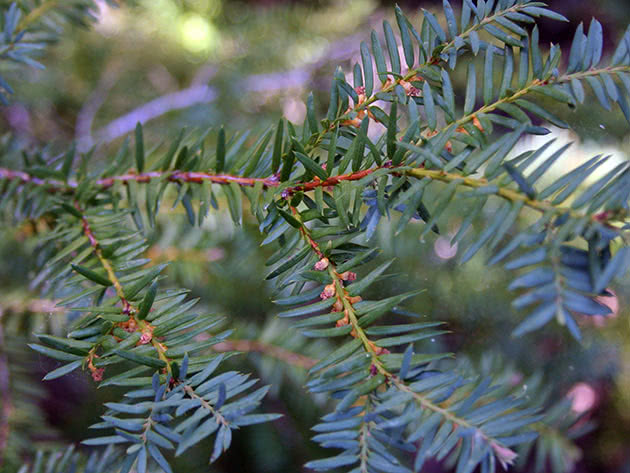

In the photo: Yew branch
Yew wintering in the garden
If a snowless winter is predicted, the yew can freeze from severe frost, so it is wrapped with spunbond or lutrasil, but this must be done using a frame so that there is space between the plant and the covering material. It is better not to use burlap to create a shelter, since it can get wet during the thaw period, and then freeze in frost. It is also undesirable to wrap yews with polyethylene and roofing felt, which do not allow air to pass to the branches. When the soil warms up in the spring, the shelter is removed, but until fresh growths appear on the yew, it must be protected from the sun's rays, which at this time of the year pose a serious danger to conifers: in sunny and windy weather, when the roots of the yew is not yet able to absorb moisture, and the needles evaporate it intensively, yews can easily be damaged. Therefore, trees should be shaded from the bright sun.
Care
The condition and life span of the plant depends on proper care. Young berry yews are more demanding in terms of lighting and watering than adult trees. But taking care of them: watering, feeding, pruning, protecting from frost is necessary not only at the initial stage, after planting.
Watering
It is necessary to water the ephedra regularly within two years after planting. In the rainy season, watering can be completely abandoned, and in dry watering should be done once a month. 10 - 12 liters of water is enough for one tree.
The needles of berry yew need to be periodically cleaned of dust; it is recommended to irrigate it twice a month.


It is necessary to water the ephedra regularly within two years after planting.
Top dressing
For the first time, the plant is fed during planting. To do this, for each liter of substrate, take a gram of nitroammophoska and 15 milligrams of copper sulfate. The next top dressing, similar in composition, is made in a year.
Gardeners advise to fertilize plants during the growing season, annually. For these purposes, drugs such as "Kemira-wagon" or Florovit.
Pruning
Most varieties of berry yew, be they trees or shrub forms, need constant pruning. Shoots are cut at least one third of their length.
You can start giving the crown of the yew a certain shape already in the first years after planting. But this must be done with caution. It is better to start by removing damaged shoots or dry branches. Formative pruning is carried out in March - April.
Trees that have reached the age of 5 - 7 years can be thoroughly trimmed. The choice of form depends on the characteristics of the variety, its appearance. Therefore, it is important to familiarize yourself with the characteristics of a particular plant before the initial pruning.
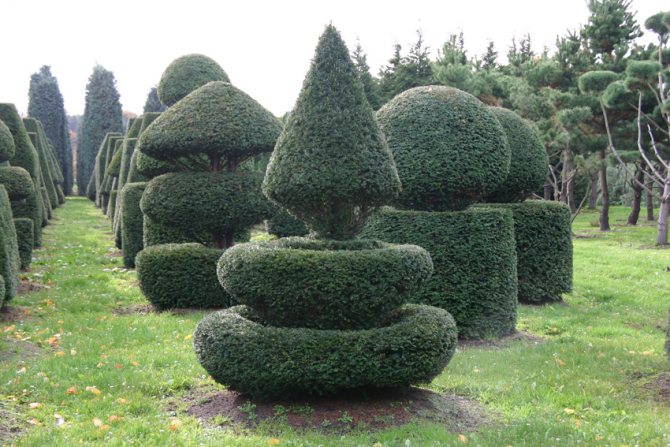

Trees that have reached the age of 5 - 7 years can be thoroughly trimmed.
Wintering
Experience shows that only young conifers should be sheltered for the winter. This can be done with peat, filling it with a layer of 6 - 7 centimeters.
Another important measure in preparing the berry yew for wintering is to protect the branches from damage. In the cold, they become more fragile, under the weight of snow or in strong winds they can break. To prevent this from happening, the branches are tied into a bundle using a thin wire or twine. Adult plants do not require such care.
Diseases and pests
Berry yew is one of the most resistant plants. But since this natural quality in ornamental crops is reduced, they suffer from the following pests and diseases:
- Yew false shield - lives on needles and thin branches of a tree, its vital activity is accompanied by blackening and shedding of needles. This is especially noticeable on the branches of the lower tier. To combat insects, insecticides are used, they do it twice - in early and mid-July with an interval of two weeks.
- Yew flatbed - a pest that forms white dots on the needles, which merge with the border along the edges of the needles.Affected trees and shrubs are treated in early spring and late May.
- Black - caused by the fungi Fumago, Capnodium, Apiosporium. Signs of the disease are a black sooty film that occurs on shoots affected by a false shield. It not only impairs the appearance, but also interferes with photosynthesis. To help the plant, it is sprayed with fungicides.
In ancient times, the beautiful and dangerous berry yew was called the tree of life and death. Now these centenarians, the oldest of whom, according to legend, grew up in the time of Pontius Pilate, are listed in the Red Book. It is not difficult to decorate a garden plot with one or more decorative varieties of the legendary tree. And the yew looks very impressive in any neighborhood.
How many years does he live
But if you answer the question "how many yews grow", many people, including those who know about long-lived trees, will certainly be surprised. In its natural habitat, this tree lives on average for 1.5-4 thousand years. Imagine, many inconspicuous trees, with a height of only 10-15 meters, found a time when Ancient Greece had not yet reached dawn, and no one even heard of the powerful Roman Empire!
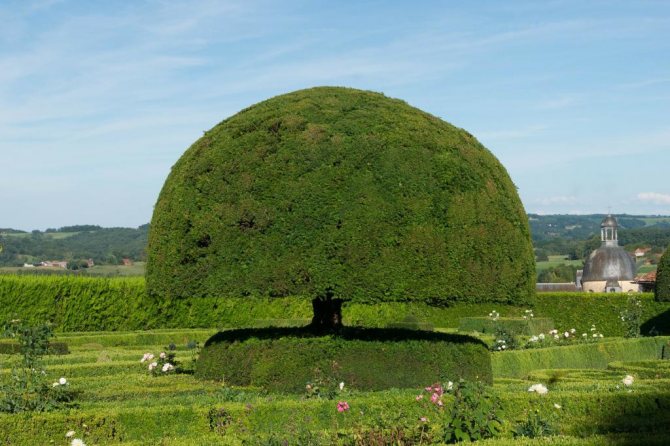

And this is not the limit at all. For example, one of the oldest yew trees in the world grows in Scotland. As established by experts, its age is about 9 thousand years! Just imagine, he hatched from a seed at a time when no more than 5 million people lived on the whole earth. Humanity only mastered agriculture.
But the tallest of the known yew trees until recently grew in South Georgia, more precisely in Adjara. Its height was 32.5 meters! Knowing how quickly the berry yew grows (and this is only 2-3 centimeters per year under favorable conditions), you can calculate how old he was. Alas, today he died due to unclear circumstances.
Use in landscape design
The main advantage of the berry yew is the ability to easily and quickly, with the help of a haircut, give it the shape of a ball or any other geometric figure, animal, column or pyramid. But even a plant that has not been cut off by a gardener looks attractive due to its lush needles and bright red berries.
Designers advise planting berry yew as hedges along paths, using it to create alpine slides and topiary. And to liven up the planting of conifers, you can decorate them with figurines, for example, garden gnomes, animals or birds.
Combination with other plants
The most successful berry yew gets along with rhododendrons and conifers, for example, with fir, dwarf pine varieties, thuja, juniper. And the mix of yew and fern creates the atmosphere of a real forest on the site.
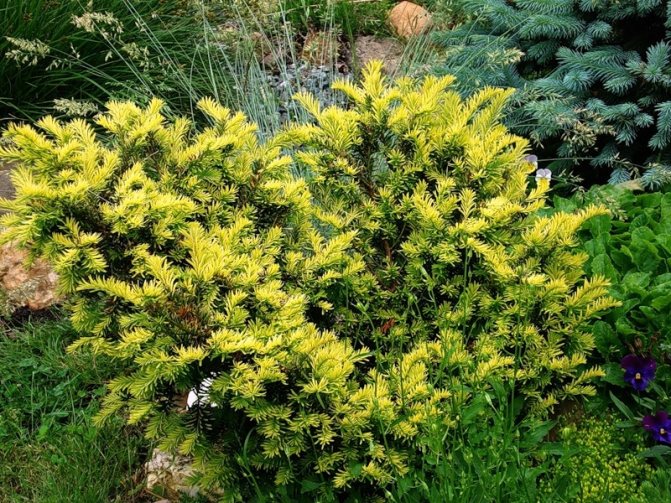

The most successful berry yew gets along with rhododendrons and conifers.
When alpine hills are formed, the ephedra becomes part of a multi-level composition and is combined not only with its evergreen "brothers", for example, with bush pines, cypresses, fir or juniper, but also with other plants. Next to the berry yew, you can plant barberry, quince, heather, violets, lavender, lingonberry, mint, lilies and irises of various colors, edelweiss, mosses.
How to prepare and store medicinal raw materials
The needles of this plant are used for medicinal purposes. All parts of this shrub are deadly poisonous, except for the berries. Therefore, the prepared raw materials are used only for external use.
During the summer season, needles are collected from the bushes and dried on open terraces or verandas in the shade. Dried raw materials should be stored in glass containers with a tightly closed lid. Place these jars in a dark, dry place. Harvested raw materials (due to their toxic properties) should be stored separately from other medicinal herbs.
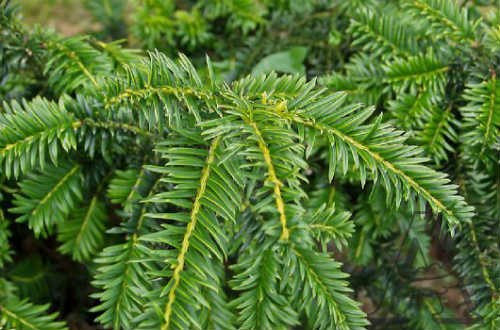

Beautiful bushes and trees of yew berry will decorate any square or summer cottage. They can be cut into the most unusual shapes.But it should be remembered - to eat yew berries, as well as needles, should be done only after consulting with specialists.
Planting a seedling
A yew berry seedling, correctly chosen for planting, is a plant with a characteristic color of the needles and trunk of the variety, the absence of spots, cracks and wounds on the bark and mold plaque on the pot in which the tree is placed. Planting work is carried out in the spring months. The soil should be warm, but not filled with moisture.
Conifers should be planted 0.5 - 3 meters apart. The distance between seedlings depends on the variety and on the expected size of the mature plants. If you plan to equip a yew hedge, then you can place the seedlings a little closer.
Having marked the distance between green spaces on the site, you can prepare a planting pit. The standard depth is 60 - 80 centimeters. The pit is filled with fertile soil. You can add complex fertilizers for ephedra.
The seedling is lowered into the hole so that the root collar is above the ground. After planting, the plant is watered, the soil is mulched with sawdust or peat.
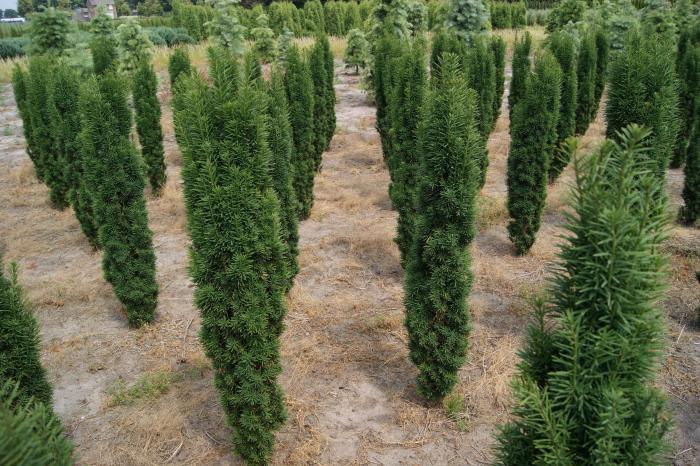

Conifers should be planted 0.5 - 3 meters apart.

